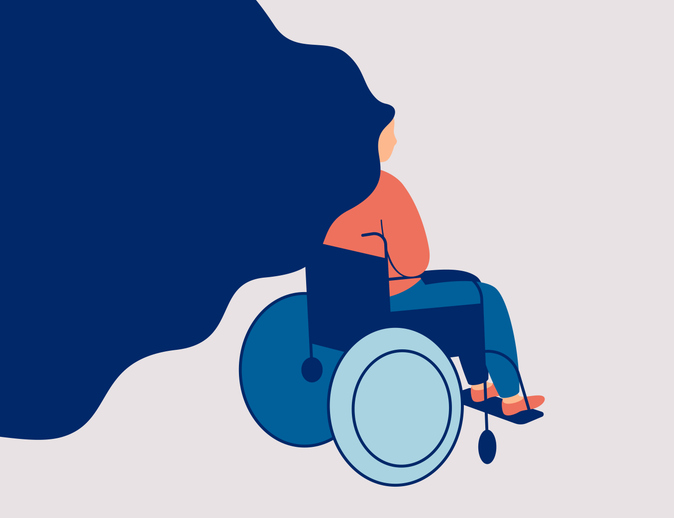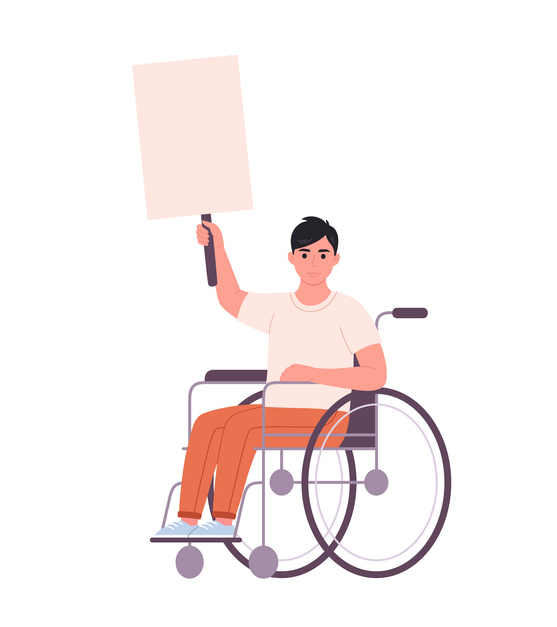
Breaking the Silence
Early Identification of Disabilities in Girls Can No Longer Be Overlooked
Kanaksha Kataria**
For decades, a grave injustice has persisted in plain sight—the systemic failure to recognize how disabilities manifest differently across genders. Despite the mounting socio-medical evidence highlighting these discrepancies, the lack of institutional attention to the unique experiences of women and girls with disabilities represents a grave inequity. This issue is starkly evident in the early identification of girls with disabilities, wherein insufficient research on how disabilities manifest differently in girls and institutional apathy and lack of awareness has resulted in inadequate identification of girls with disabilities. This is particularly troubling because early identification is crucial for timely interventions that can significantly improve developmental outcomes and quality of life for children. Without early detection, girls with disabilities miss critical windows for effective treatments, which exacerbates their marginalisation from the outset, depriving them of the support needed to thrive from a young age. Therefore, addressing this gap is essential to ensure that girls with disabilities receive the necessary support at par with all other children with disabilities, as early as possible.
The Core Problem: “Invisibility” of Girls with Disabilities
At the root of this crisis are two interrelated issues: delayed identification of disabilities and outdated methods of data collection. Most government data collection in India does not account for the influence of sex and gender on disability prevalence and presentation. The parameters on which data is collected are outdated, resulting in many women not being counted accurately in disability statistics. The 2011 Census identified 11.8 million women with disabilities out of 26.8 million Indians with disabilities—a figure experts regard as a gross undercount compared to the World Health Organization’s estimate that 15% of any given population is disabled.
The primary cause of such underreporting of the number of women with disabilities is the limited information on women with disabilities collected by surveys such as the 2011 Census. The 2011 Census used overly simplistic categories like ‘mental retardation’ and ‘mental illness’. These terms failed to distinguish between important conditions such as learning disabilities, intellectual disabilities and neurodevelopmental disorders. This data blind spot perpetuates institutional inertia, allowing the marginalisation of women and girls with disabilities to persist. Without understanding how factors like biological sex and socio-cultural gender norms impact disability experiences, legal and policy reforms lack a solid basis.
Further, the delayed identification of disabilities in girls exacerbates this problem. Perhaps the most glaring manifestation of this systemic injustice is the underdiagnosis and lack of early interventions provided to girls exhibiting indicators of neurodevelopmental disorders, like Attention Deficit Hyperactivity Disorder (ADHD) and Autism Spectrum Disorder (ASD). Across these conditions, the symptomatic traits frequently displayed by females – including internalised behaviours, inattentive subtypes, and co-occurring mood disorders – represent a stark contrast from more overtly disruptive presentations that have traditionally constituted the clinical diagnostic criteria. This prioritises male typical characteristics as indicators of neurodevelopmental disorders, resulting in the underdiagnosis of girls and women.
As a result, girls are plagued by delayed diagnosis timelines and are routinely gaslighted by instructors, medical professionals, and even their own support systems. Experiences of girls with disabilities are evaluated through the lens of gendered norms. This minimises their lived experiences as emotional overreactions, personality quirks, or underperformance rather than legitimate disabilities. For instance, in two studies where teachers were given brief ADHD-like descriptions, they were more likely to suggest the child be referred for additional support and treatment when the description featured a male name and pronouns. This bias exemplifies how lived experiences of girls with neurodevelopmental conditions are systemically invalidated.
Therefore, the absence of both early identification mechanisms and accurate data collection systems results in girls with disabilities slipping through the cracks, compounding their marginalisation and hindering effective intervention strategies.
Manifestations of Marginalisation
The systemic failure to identify girls with disabilities effectively and in a timely manner, sets off a destructive domino effect perpetuating their marginalisation across all spheres. With their population size vastly undercounted due to missed and delayed diagnoses, policymakers lack comprehensive data affirming them as a critical stakeholder group. This fuels the institutional inertia to prioritise initiatives which uphold the rights and accommodations required by women with disabilities. For instance, flagship schemes under the Right to Education Act, 2009 fail to account for disability-focused entitlements when conducting gender budgeting analyses.
The lack of proactive, gender-responsive screening and diagnostic protocols obfuscates the true population numbers of women with disabilities, perpetuating this cycle of neglect. Without this foundational data to establish an accurate baseline, policymakers do not have incentives to prioritise targeted interventions for women with disabilities across sectors, from healthcare to workplace accommodations. Only by addressing the issues with the early identification of women with disabilities can this systemic blind spot be corrected – ensuring that they are recognised as a priority stakeholder group and they are accounted for in policy decisions.
The Way Forward
Achieving timely and accurate early identification for girls with disabilities in India demands learning from and adapting proven global best practices. At the grassroots level, community-driven interventions transforming attitudes and upskilling ecosystems are vital first steps. In tandem, overhauling professional competencies through comprehensive policy guidance is key.
Gender-Inclusive Universal Screening Programs: Comprehensive screening programs across educational and medical service delivery systems, should include gender-inclusive clinical diagnostic criteria. For instance, the UK’s National Health Service has issued specific guidelines promoting gender-sensitive approaches to recognize and diagnose neurodevelopmental conditions in girls. Developing similar frameworks calibrated to Indian socio-cultural contexts could enhance diagnostic accuracy and symptom recognition nationwide. Existing initiatives like the Rashtriya Bal Swasthya Karyakram, while representing a starting point, require expansion to incorporate broader gender analyses.
Robust data collection mechanisms: Identification capabilities cannot be effectively operationalized without robust data underpinnings. UN Women’s Making Every Woman and Girl Count program highlights the critical need for disability disaggregation across all gender data – a current blind spot in India’s datasets contributing to underrepresentation and undercounting of girls with disabilities. Partnering with such organisations can fast-track developing these vital data transparencies.
Capacity Building for Early Identification: Rigorous training curriculums are needed to equip teachers, counsellors, social workers, and paediatricians with the competencies to recognise differential symptomatic presentations across genders. Establishing these skills can empower relevant stakeholders to become flag-bearers of gender-inclusive early identification, rather than bystanders reinforcing biases. For instance, initiatives like Humanity & Inclusion’s Girls’ Access to Education (GATE) project provide blueprints for training teachers, adapting school environments, and reshaping perspectives to be more inclusive and identification-focused regarding girls with disabilities.
Policy Standards: Policies for educational institutions, medical facilities, and public spaces must incorporate gender-specific analyses. This can help combat biases that lead to underdiagnosis of disabilities in girls. The standards should include clear roadmaps for implementing gender-inclusive practices in disability identification. This approach can further a system that better responds to the unique needs of girls with disabilities from an early age.
Expanding Research: Substantive reforms will also require expanding India’s research portfolio into the clinical and neurobiological nuances of how various conditions manifest across genders. Preliminary studies have shed light on key distinctions, but further interdisciplinary collaboration can accelerate understanding, extending diagnostic sensitivity for early intervention.
Conclusion
Ultimately, improving early identification demands a unified national strategy promoting three core pillars: grassroots sensitivity through community interventions, codifying professional competencies through inclusive standards and training, and prioritising data-driven evidence by mainstreaming gender-disability intersections.
While implementing this reorientation will require reallocating resources and political capital, the moral and socioeconomic imperative is clear. Every year, millions of Indian girls face lifelong challenges simply due to systemic identification failures representing an unconscionable drain on human potential. Operationalizing best practices into a cohesive agenda is the key to upending this destructive status quo.
With its vast capabilities and reservoirs of civic resolve, India possesses all the ingredients required to urgently initiate this transformation. The path forward is clear – only the willpower to finally walk it remains.
**Kanaksha Kataria is a 3rd year law student at National Academy of Legal Studies and Research (NALSAR), Hyderabad


